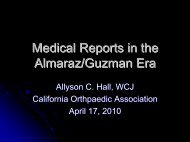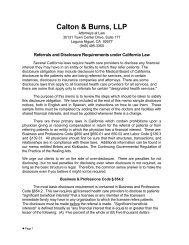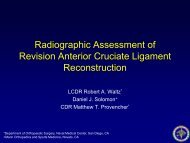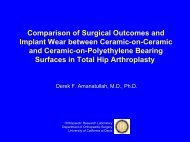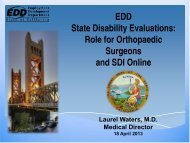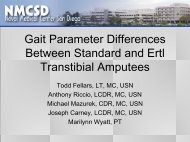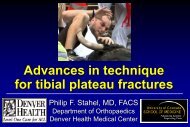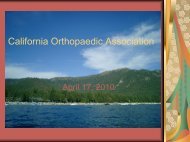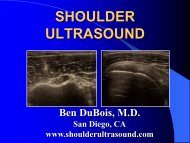Enhancing Your Practice's Revenue - California Orthopaedic ...
Enhancing Your Practice's Revenue - California Orthopaedic ...
Enhancing Your Practice's Revenue - California Orthopaedic ...
- No tags were found...
Create successful ePaper yourself
Turn your PDF publications into a flip-book with our unique Google optimized e-Paper software.
individual to a person for the furnishing or arranging forthe furnishing of any item or service for which paymentwill be made in whole or in part under governmentprograms including, Medicare, Medicaid, TriCare andCHAMPUS.” Distributions made in connection withany physician hospital joint venture must not be disguisedremunerations for referrals.Anti-kickback is a criminal statute. A violation of thelaw is a felony offense that carries criminal fines of up to$25,000 per violation, imprisonment for up to five yearsand exclusion from government health care programs. Thestatute currently has 23 “safe harbors.” (Note: these are notthe same thing as the Stark “exceptions.”) Safe harbors protectpeople who have entered into specified arrangementscovered by the statute from criminal and civil prosecution.To be fully protected by a safe harbor, an arrangementmust fit squarely into the safe harbor. Failure to complywith a safe harbor provision, however, does not mean thatan arrangement is illegal.Note relating to physician hospital ASC joint ventures:the Office of the Inspector General (“OIG”) of Health andHuman Services (HHS) released Advisory Opinion 98-12on September 23, 1998. In that opinion the OIG indicatedthat it would not take action against an ASC facility evenif the requisite intent was to induce referrals. The OIGconcluded ASCs are less expensive than hospital inpatientsurgery facilities and offer a setting that is preferred bymany patients.The OIG proposed a safe harbor to protect surgeonswho, as an extension of their personal office practice,routinely perform procedures in ASCs in which they havean investment interest. Legitimate reasons for surgeons toperform services in an ASC in which they have an investmentinterest include personal and patient convenience,professional autonomy, accountability, and quality control.However, Advisory Opinion 98-12 is conditioned on eachof the participating physicians generating at lease onethirdof their total medical practice income from performingASC procedures. Physician investors need to providepatients with a written disclosure of their ownership in theASC.In 1999 the OIG finalized the ASC safe harbor thatprotects physician-hospital ASC joint ventures. Because thissafe harbor is tailored to ASCs, many joint ventures offeringnon-surgical services are ineligible for protection underthis safe harbor.Readers are strongly encouraged to seek competent legal counselto understand the complex issues associated with the antikickbackstatute and the associated safe harbors as they relate tophysician hospital joint ventures.State RegulationsIn addition to the federal regulations, readers should bearin mind that individual states may have laws that need tobe taken into consideration. These include “Certificate ofNeed” requirements, state licensing standards, state selfreferral,kickback, or fee-splitting prohibitions, and statesecurities laws.Other Considerations relating toDistribution of Joint Venture <strong>Revenue</strong>sCMS issued a ruling that took effect on October 1, 2009eliminating the “per procedure” (per click) and percentagebasedreimbursement on equipment and rental space. Also,in January 2009 a revision to the anti-markup rule tookeffect which prohibits physicians from marking up chargesfor the technical or professional components of Part Bdiagnostic tests purchased from a third party unless the testare performed in the same building as the billing physician.In July 2008, CMS issued a proposed exception to theStark Law that would cover incentive payment programsalso known as “pay-for-performance” and shared savingsprograms. Shared savings programs are commonly referredto as “gainsharing” arrangements. In ‘gainsharing” arrangements,the hospital contracts with a group of physicians toset targets for cost savings on the use of supplies and implants.The hospital then pays the physicians a portion ofsavings achieved. In a “pay-for-performance” arrangementthe hospital pays physicians cash incentives for achievingobjective, clearly defined, quality measures.Regulations are always changing, however, so as statedabove it is critical for physicians who are in a JV with a hospital(or who are contemplating entering into one) to retainlegal counsel and conduct conferences with that individualon a regular basis. Alternative sources of information includeAAOS Now and the Government Relations segmentof the AAOS website (www.aaos.org.)Take-away Messages• Physician-hospital joint ventures are a way fororthopaedic surgeons to maintain their income while atthe same time providing high-quality, lower-cost patientcare.• Generally speaking it is easier for physicians in largergroups to enter into JV arrangements with theirhospitals.• However, with careful planning it may be possiblefor solo practitioners and physicians in smaller grouppractices to do this as well.• All physicians, whether they practice in one setting ormany, must have a shared vision of what they collectivelywant to achieve, and this vision must be in sync withthat of the hospital.• Development of a successful joint venture requires© 2011 American Academy of <strong>Orthopaedic</strong> Surgeons31




